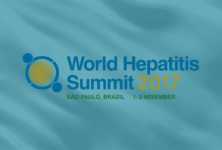A Q&A with HIV cure science superstars
What’s going on in HIV cure research? Is it ethical to take people off of HIV antiretrovirals if they participate in HIV cure research? And, do you think we’ll have a functional cure for HIV in the next few years? These were some of the questions that lead researchers who are part of the amfAR Institute for HIV Cure Research at UCSF tackled at a forum on World AIDS Day this year.
After a thorough presentation on progress the Institute for HIV Cure Research has made in the previous year, the panel of scientists—and one long-term survivor from the community—answered questions about the search for an HIV cure. Here’s what we learned.
When will we have a cure for HIV?
“People often ask me this,” said Steve Deeks, MD, “and honestly—I have no idea. But I’m hoping we’ll have a regimen—a combination that’s viable and testable, by the time the current funding of this institute is over, in the next few years. That’s an optimistic perspective,” he said.
Deeks compared where HIV cure scientists are now to where HIV treatment researchers were back in the early ‘90s. “Nobody in 1993 had any idea that we’d actually be able to control the virus. But yet, three years later—we did.”
HIV persists in the body because there are latently-infected HIV cells that aren’t killed off by antiretrovirals (the HIV “reservoir”). If a person is on antiretroviral therapy for many years—and maintains an undetectable viral load during this time—won’t the latently-infected HIV CD4 cells eventually die?
Latently-infected HIV reservoir cells can, unfortunately, last for a very long time, said Deeks. “Two studies have shown that they can last 70 to 75 years.”
“I’d even challenge those numbers,” said Warner Greene, MD, PhD. Cells in the latent reservoir, he said, can divide in order to maintain their presence in tissues throughout the body. “There’s another school of thought that says that [the latent reservoir] is going to be there forever until you attack it.”
How long does it take for the HIV reservoir, of latently infected HIV CD4 cells, to be established in the body after a person is infected? Do people who start antiretroviral therapy a long time after they were first infected have larger reservoirs, or reservoirs that are harder to target with cure therapies?
The HIV reservoir gets established fairly soon after infection, said Deeks, usually by 15 to 28 days after a person is first infected. Between weeks two to four, the reservoir “goes up by 100- to 1,000-fold, so a lot happens in that critical two-week window.”
Although it can be challenging for people to start antiretroviral therapy very soon after they’ve been diagnosed, “every minute counts during that time period,” said Deeks. The sooner a person starts antiretroviral therapy after they’re first infected, the fewer latently-infected HIV CD4 cells they will have in their viral reservoir. After that period, the sooner you start therapy, the more you’ll preserve the functioning of your immune system.
People who start HIV therapy late will have larger HIV reservoirs, said Peter Hunt, MD. In addition, HIV cure strategies that rely on harnessing the power of a person’s immune system to target and clear HIV-infected cells may work less well if a person has started HIV treatment very late.
Are there any other viruses that behave like HIV?
In general, said Greene, viruses pursue one of two strategies to stay alive and persist in their host organism. “They either chronically replicate [make copies of itself], or they form latency. Most viruses choose one or the other, but HIV does both.”
Are there any differences between men and women in HIV reservoirs, and cure research?
“We’ve known for a long time that there are differences between men and women when it comes to the biology of HIV,” said Hunt. Women who are not on ART tend to have lower viral loads than men who are not on ART, at any given CD4 count. And, female sex hormones, like estrogen, seem to actually suppress HIV re-activation (when latently infected cells start producing virus)—which keeps HIV in hiding, he said.
Greene explained that there are sex differences in how well different “shocking” agents—toll-like receptor (TLR) agonists—work in men compared to women. Women’s dendritic cells respond less well to TLR-7 agonists, whereas TLR-9 agonists seem to work equally well in men and women.
The bottom line, said Deeks, is that if the research community is serious about finding out if sex-based differences in HIV cure therapies exist, they will need to purposefully conduct studies to answer those questions.
Why do HIV cure researchers have to take people off of their antiretroviral medications? Is this ethical?
“There’s no Magic 8 ball that tells us how well a cure strategy has worked,” said Satish Pillai, PhD.
In order to figure out if an HIV cure therapy was effective, said Greene, you have to take the person off of their antiretrovirals. “It’s the gold standard,” he said. “The only way we knew the Boston patients weren’t cured, or the Mississippi baby for that matter, was because their virus rebounded after their therapy was stopped.”
These days, antiretroviral drugs are so powerful that most people taking them have “undetectable” levels of virus in their blood. And latently-infected HIV cells are very rare—they make up 1 out of every million CD4 cells—so they are extremely difficult to find. Measurement strategies are crude, and scientist don’t yet have a measurement strategy specific or sensitive enough to determine if a person is truly free from latently-infected HIV cells.
HIV cure research protocols now, said Deeks, are extremely careful and conservative when it comes to stopping people’s antiretroviral therapy. “We’re not going to stop therapy and tell people to come back in three months. We stop therapy, and see people two to three times a week during the time when it’s likely the virus will come out. So we monitor the virus very carefully.”
Just last week, said Deeks, his team saw a participant who went off ART but had their virus rebound to 50 copies/mL. “We immediately started that person back on therapy. We don’t need to watch the virus go crazy, we just need to know when it comes out.”
Let’s assume we do find an HIV cure. There are 37 million people living with HIV now. What are your predictions about our ability to deploy it around the world?
In order for an HIV cure therapy to have a global impact, it has to be safe, effective and scalable, said Deeks. “We did a study with the Gates Foundation, which asked this question. And they did a lot of modeling, and found that it has got to be something that can be administered in a small clinic, for a short period of time—say up to six months. And, it can’t cost more than $1,500 [per person]. In my mind, I can imagine a finite six-month regimen with two or three different drugs that you can add onto a stable [ART] regimen that will be safe—that won’t require long-term treatment in a hospital bed. That could in theory work, and would be a game changer.”
Matt Sharp, you’re a community member who participated in a gene therapy cure study five years ago. After listening to these presentations, what’s your sense of how things are going?
“It’s really encouraging to see this project get into the weeds, said Sharp. “Determining the measurements, but also getting into the clinic. It’s also a bit daunting, for me as a patient, knowing that I probably won’t be cured. I mean—maybe. I’ll keep my fingers crossed. But to see that the legacy of what’s happening at this point will one day get us there, I’m still very encouraged and optimistic.”


 ПОИСК ПО САЙТУ
ПОИСК ПО САЙТУ  поиск по ресурсному центру
поиск по ресурсному центру 



